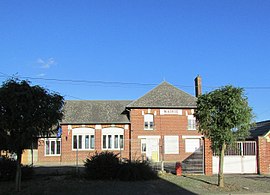Hancourt | |
|---|---|
 The town hall in Hancourt | |
| Coordinates: 49°54′14″N 3°04′24″E / 49.9039°N 3.0733°E | |
| Country | France |
| Region | Hauts-de-France |
| Department | Somme |
| Arrondissement | Péronne |
| Canton | Péronne |
| Intercommunality | Haute Somme |
| Government | |
| • Mayor (2020–2026) | Philippe Waree[1] |
| Area 1 | 4.06 km2 (1.57 sq mi) |
| Population (2021)[2] | 89 |
| • Density | 22/km2 (57/sq mi) |
| Time zone | UTC+01:00 (CET) |
| • Summer (DST) | UTC+02:00 (CEST) |
| INSEE/Postal code | 80413 /80240 |
| Elevation | 82–110 m (269–361 ft) (avg. 102 m or 335 ft) |
| 1 French Land Register data, which excludes lakes, ponds, glaciers > 1 km2 (0.386 sq mi or 247 acres) and river estuaries. | |
Hancourt (French pronunciation: [ɑ̃kuʁ]) is a commune in the Somme department in Hauts-de-France in northern France.
Geography
[edit]Hancourt is situated on the D15 and D194 crossroads, some 10 miles (16 km) northwest of Saint-Quentin.
History
[edit]Hancourt was the French village to which the 22 survivors of the 2/4th Battalion of the Oxfordshire and Buckinghamshire Light Infantry retreated in spring 1918, after the Battalion was virtually wiped out in action on the Western Front.[3]
Population
[edit]| Year | Pop. | ±% p.a. |
|---|---|---|
| 1968 | 132 | — |
| 1975 | 117 | −1.71% |
| 1982 | 92 | −3.38% |
| 1990 | 117 | +3.05% |
| 1999 | 100 | −1.73% |
| 2007 | 103 | +0.37% |
| 2012 | 102 | −0.19% |
| 2017 | 92 | −2.04% |
| Source: INSEE[4] | ||
See also
[edit]References
[edit]- ^ "Répertoire national des élus: les maires". data.gouv.fr, Plateforme ouverte des données publiques françaises (in French). 2 December 2020.
- ^ "Populations légales 2021" (in French). The National Institute of Statistics and Economic Studies. 28 December 2023.
- ^ Bullock, Arthur (2009). Gloucestershire Between the Wars: A Memoir. The History Press. ISBN 978-0-7524-4793-3. (Page 61)
- ^ Population en historique depuis 1968, INSEE
Wikimedia Commons has media related to Hancourt.


